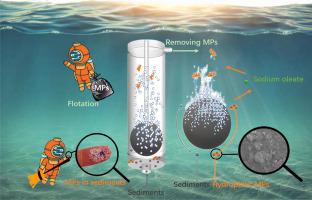Chemical Engineering Journal ( IF 15.1 ) Pub Date : 2022-06-20 , DOI: 10.1016/j.cej.2022.137692 Hongru Jiang , Yingshuang Zhang , Kai Bian , Chongqing Wang , Xu Xie , Hui Wang , Hailong Zhao

|
Microplastics (MPs) contamination in sediments is becoming an intractable environmental issue. Numerous methods are proposed for removing microplastics from aqueous solution, however, the techniques developed for microplastic removal from sediments have been rarely reported. To target the dilemma, this work innovatively applied froth flotation to the MPs removal from beach and lake sediments. Interestingly, we found that the sediment particle adhered to the MPs surfaces resulted in unavailable attachment of air bubbles to MPs surfaces. The effects of pH, salinity, moisture, MPs property, sediment type, and incubation time on MPs flotation were systematically investigated. According to characterization, polyvinyl chloride (PVC) was only covered by aluminosilicate, while acrylonitrile butadiene styrene (ABS) interacted with aluminosilicate and quartz. Analysis of Extended Derjaguin Landau Verwey Overbeek (EDLVO) further confirmed that the stronger electrostatic repulsion between PVC and sediment contributed to the higher energy barrier. However, sediment particles were easier to adhere to ABS with less negative surface potential. Besides, metal ions adsorbed on MPs surfaces might serve as a bridge to link MPs and sediment particles. To improve the flotation performance, a flotation process combined 10 g/ton of sodium oleate could achieve approximately 100% removal of MPs. To further evaluate the applicability of froth flotation, we conducted life cycle assessment (LCA) and economic assessment. Froth flotation outperformed other separation methods in all environment categories. The cost of froth flotation, mostly electricity, was much lower than other removal technologies. Overall, this work provided an effective and sustainable candidate for MPs removal from the sediment environment.
中文翻译:

是否可以使用泡沫浮选有效且可持续地去除沉积物中的微塑料?
沉积物中的微塑料 (MPs) 污染正在成为一个棘手的环境问题。提出了许多从水溶液中去除微塑料的方法,但是,很少报道开发用于从沉积物中去除微塑料的技术。针对这一困境,这项工作创新地将泡沫浮选应用于从海滩和湖泊沉积物中去除 MPs。有趣的是,我们发现附着在 MPs 表面的沉积物颗粒导致气泡无法附着到 MPs 表面。系统研究了pH、盐度、水分、MPs性质、沉积物类型和培养时间对MPs浮选的影响。根据表征,聚氯乙烯(PVC)仅被铝硅酸盐覆盖,而丙烯腈丁二烯苯乙烯(ABS)与铝硅酸盐和石英相互作用。Extended Derjaguin Landau Verwey Overbeek (EDLVO) 的分析进一步证实,PVC 和沉积物之间较强的静电排斥有助于提高能垒。然而,沉积物颗粒更容易粘附在具有较小负表面电位的 ABS 上。此外,吸附在 MPs 表面的金属离子可以作为连接 MPs 和沉积物颗粒的桥梁。为了提高浮选性能,结合 10 克/吨油酸钠的浮选工艺可以实现约 100% 的 MPs 去除率。为了进一步评估泡沫浮选的适用性,我们进行了生命周期评估(LCA)和经济评估。泡沫浮选在所有环境类别中都优于其他分离方法。泡沫浮选的成本,主要是电力,远低于其他清除技术。总体而言,这项工作为从沉积物环境中去除 MPs 提供了一种有效且可持续的候选方案。



























 京公网安备 11010802027423号
京公网安备 11010802027423号